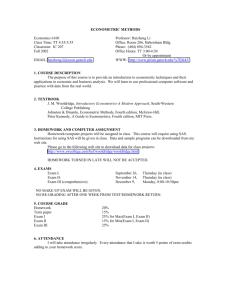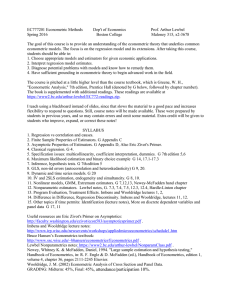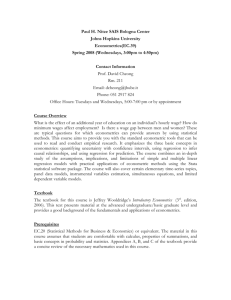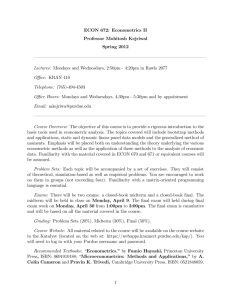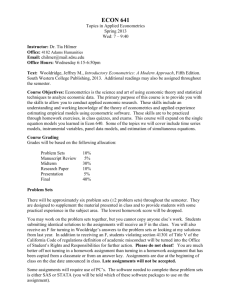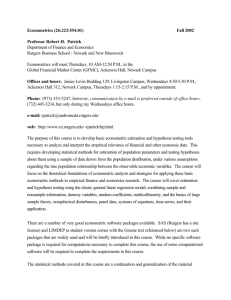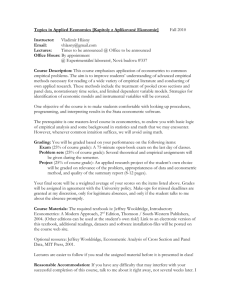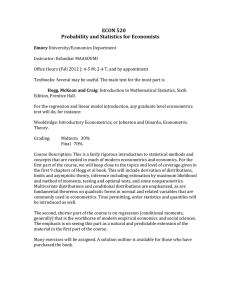Nonlinear Econometric Analysis (ECO 722) Hunter College Spring 2016
advertisement
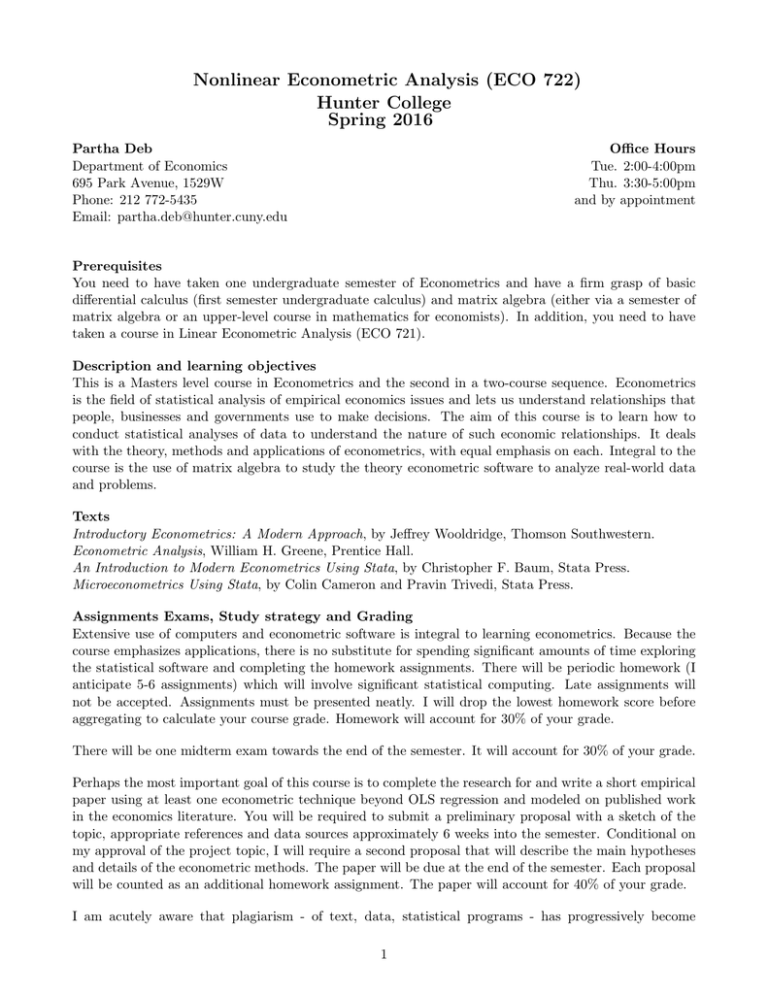
Nonlinear Econometric Analysis (ECO 722) Hunter College Spring 2016 Partha Deb Department of Economics 695 Park Avenue, 1529W Phone: 212 772-5435 Email: partha.deb@hunter.cuny.edu Office Hours Tue. 2:00-4:00pm Thu. 3:30-5:00pm and by appointment Prerequisites You need to have taken one undergraduate semester of Econometrics and have a firm grasp of basic differential calculus (first semester undergraduate calculus) and matrix algebra (either via a semester of matrix algebra or an upper-level course in mathematics for economists). In addition, you need to have taken a course in Linear Econometric Analysis (ECO 721). Description and learning objectives This is a Masters level course in Econometrics and the second in a two-course sequence. Econometrics is the field of statistical analysis of empirical economics issues and lets us understand relationships that people, businesses and governments use to make decisions. The aim of this course is to learn how to conduct statistical analyses of data to understand the nature of such economic relationships. It deals with the theory, methods and applications of econometrics, with equal emphasis on each. Integral to the course is the use of matrix algebra to study the theory econometric software to analyze real-world data and problems. Texts Introductory Econometrics: A Modern Approach, by Jeffrey Wooldridge, Thomson Southwestern. Econometric Analysis, William H. Greene, Prentice Hall. An Introduction to Modern Econometrics Using Stata, by Christopher F. Baum, Stata Press. Microeconometrics Using Stata, by Colin Cameron and Pravin Trivedi, Stata Press. Assignments Exams, Study strategy and Grading Extensive use of computers and econometric software is integral to learning econometrics. Because the course emphasizes applications, there is no substitute for spending significant amounts of time exploring the statistical software and completing the homework assignments. There will be periodic homework (I anticipate 5-6 assignments) which will involve significant statistical computing. Late assignments will not be accepted. Assignments must be presented neatly. I will drop the lowest homework score before aggregating to calculate your course grade. Homework will account for 30% of your grade. There will be one midterm exam towards the end of the semester. It will account for 30% of your grade. Perhaps the most important goal of this course is to complete the research for and write a short empirical paper using at least one econometric technique beyond OLS regression and modeled on published work in the economics literature. You will be required to submit a preliminary proposal with a sketch of the topic, appropriate references and data sources approximately 6 weeks into the semester. Conditional on my approval of the project topic, I will require a second proposal that will describe the main hypotheses and details of the econometric methods. The paper will be due at the end of the semester. Each proposal will be counted as an additional homework assignment. The paper will account for 40% of your grade. I am acutely aware that plagiarism - of text, data, statistical programs - has progressively become 1 technically easier and thus more tempting. I do not tolerate it and will assign a summary F if I suspect it. I am also aware that there are growing numbers of individuals and organizations that offer ”expert advice” and/or complete papers. These are unacceptable as well. Hunter College regards acts of academic dishonesty (e.g., plagiarism, cheating on examinations, obtaining unfair advantage, and falsification of records and official documents) as serious offenses against the values of intellectual honesty. The College is committed to enforcing the CUNY Policy of Academic Integrity and will pursue cases of academic dishonesty according to the Hunter College Academic Integrity Procedures. Course Topics 1. Mathematics and Statistics Prerequisites a. Wooldridge, Appendices A–E b. Baum – Chapters 2-8 and Appendices 2. The Linear Regression Model a. Wooldridge, Chapter 3, Appendix E: Estimation and Interpretation b. Wooldridge, Chapters 3–7: Inference c. Wooldridge, Chapters 8 and 9: Specification Issues 3. Instrumental Variables and Simultaneous Equations Models a. Wooldridge, Chapters 15 and 16 4. Maximum Likelihood Estimation a. Wooldridge – Chapter 17 b. Greene – Chapter 14 (14.1, 14.2, 14.9.1) 5. Binary Outcomes: Linear Probability, Probit and Logit a. b. c. d. Wooldridge – Chapter 17 Greene – Chapter 17 (17.2, 17.3) Baum – Chapter 10 Cameron and Trivedi – Chapter 14 6. Multinomial Outcomes: Ordered and Unordered a. Greene – Chapter 18 (18.2, 18.3) b. Cameron and Trivedi – Chapter 15 7. Panel Data Analysis a. b. c. d. Wooldridge – Chapters 13, 14 Greene – Chapter 11 (11.2, 11.3, 11.4) Baum – Chapter 9 Cameron and Trivedi – Chapter 8 8. Count Outcomes: Poisson, Negative Binomial, and extensions a. Wooldridge – Chapter b. Greene – Chapter 18 (18.4) c. Cameron and Trivedi – Chapter 17 9. Selection Bias and Censoring a. Wooldridge – Chapter 17 Long, Greene – Chapter 19 (19.3) b. Cameron and Trivedi – Chapter 16 (16.6) 2
